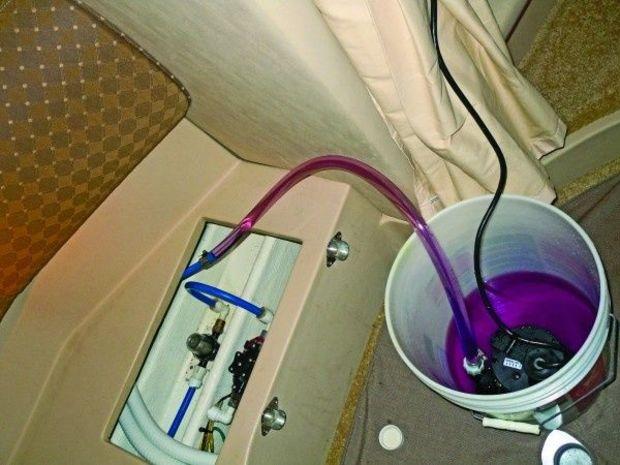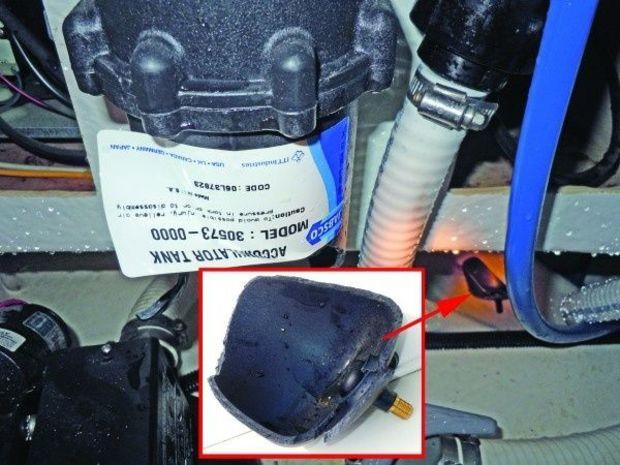
After a few decades of boat ownership, I’ve come to realize this time of year is more about work than enjoyment; that period where another great season’s chapter on the water closes, and the future plot is more about suspense and character building than exciting action. But more importantly, I learned to focus on what’s important for a boat’s winter layup.
Preparing a boat for storage is really only about four things: preventing ice expansion damage, completing yearly maintenance, stabilizing fuel systems, and removing anything that can mold. It’s about ensuring that boats left in the water over winter have no leaks in thru-hulls and preventing topsides from collecting water or snow.
What used to take me days to complete now takes an hour or two, not solely because I became more efficient; rather because I started ignoring the things that don’t matter right now. Oddly enough, the quickest way to winterize a boat is focusing on everything in reversed order of importance.
Remove all paper products from your boat and then wipe down and vacuum her to prevent Doritos crumbs from attracting mold or feeding the wildlife. Pull off any bedding or towels. Don’t focus on showroom shine, since you’ll be doing that in the spring anyway. Don’t leave canvas or standing water anywhere under a winter cover. Open drawers, lockers, and refrigerators for airflow.
Put fuel stabilizer in your tanks now, filling with fresh fuel afterward to ensure stabilizer doesn’t sit in your fill-tube. Don’t overfill, especially if stored on land or trailered. Make sure stabilizer reaches engines (and generator) by warming them to operating temperature.

Drain and replace warmed engine oil, and replace lower-unit gear oil later if so equipped. Install new oil filters; pull the spark plugs and replace (one at a time); pull the distributor caps plus rotors and replace; and pull the fuel filters and replace. Now is the time to spend $100 on these fresh parts, not in the spring when you’re anxious to get out on the water. Don’t allow old oil or filters with moisture to sit over winter, and don’t try to get one more season out of consumable parts. Lower units with any sign of milky oil must be taken inside over winter for service.
Finally, put pink antifreeze through freshwater or seawater system, running them until you see pink ejected out every thru-hull or faucet. Ensure any trailered or jacked boat is lower in the stern with the transom plug pulled. I always pulled my trailered boats’ batteries and stored in a garage to prevent freezing, but in-water boats need battery chargers all winter to operate bilge pumps.
You can drain all your water systems per manufacturer recommendations, but never assume drains reach everywhere. Running the pink stuff through everything first is cheap insurance that prevents any trapped water from ruining your spring launch. Been there, done that; avoid it.
by Mike Edick After a few decades of boat ownership, I’ve come to realize this time of year is more about work than enjoyment; that period where another great season’s chapter on the water closes, and the future plot is more about suspense and character building than exciting action. But more importantly, I learned to focus on what’s important for a boat’s winter layup.
Preparing a boat for storage is really only about four things: preventing ice expansion damage, completing yearly maintenance, stabilizing fuel systems, and removing anything that can mold. It’s about ensuring that boats left in the water over winter have no leaks in thru-hulls and preventing topsides from collecting water or snow.
What used to take me days to complete now takes an hour or two, not solely because I became more efficient; rather because I started ignoring the things that don’t matter right now. Oddly enough, the quickest way to winterize a boat is focusing on everything in reversed order of importance.
Remove all paper products from your boat and then wipe down and vacuum her to prevent Doritos crumbs from attracting mold or feeding the wildlife. Pull off any bedding or towels. Don’t focus on showroom shine, since you’ll be doing that in the spring anyway. Don’t leave canvas or standing water anywhere under a winter cover. Open drawers, lockers, and refrigerators for airflow.
Put fuel stabilizer in your tanks now, filling with fresh fuel afterward to ensure stabilizer doesn’t sit in your fill-tube. Don’t overfill, especially if stored on land or trailered. Make sure stabilizer reaches engines (and generator) by warming them to operating temperature.
After a few decades of boat ownership, I’ve come to realize this time of year is more about work than enjoyment; that period where another great season’s chapter on the water closes, and the future plot is more about suspense and character building than exciting action. But more importantly, I learned to focus on what’s important for a boat’s winter layup.
Preparing a boat for storage is really only about four things: preventing ice expansion damage, completing yearly maintenance, stabilizing fuel systems, and removing anything that can mold. It’s about ensuring that boats left in the water over winter have no leaks in thru-hulls and preventing topsides from collecting water or snow.
What used to take me days to complete now takes an hour or two, not solely because I became more efficient; rather because I started ignoring the things that don’t matter right now. Oddly enough, the quickest way to winterize a boat is focusing on everything in reversed order of importance.
Remove all paper products from your boat and then wipe down and vacuum her to prevent Doritos crumbs from attracting mold or feeding the wildlife. Pull off any bedding or towels. Don’t focus on showroom shine, since you’ll be doing that in the spring anyway. Don’t leave canvas or standing water anywhere under a winter cover. Open drawers, lockers, and refrigerators for airflow.
Put fuel stabilizer in your tanks now, filling with fresh fuel afterward to ensure stabilizer doesn’t sit in your fill-tube. Don’t overfill, especially if stored on land or trailered. Make sure stabilizer reaches engines (and generator) by warming them to operating temperature.
 Drain and replace warmed engine oil, and replace lower-unit gear oil later if so equipped. Install new oil filters; pull the spark plugs and replace (one at a time); pull the distributor caps plus rotors and replace; and pull the fuel filters and replace. Now is the time to spend $100 on these fresh parts, not in the spring when you’re anxious to get out on the water. Don’t allow old oil or filters with moisture to sit over winter, and don’t try to get one more season out of consumable parts. Lower units with any sign of milky oil must be taken inside over winter for service.
Finally, put pink antifreeze through freshwater or seawater system, running them until you see pink ejected out every thru-hull or faucet. Ensure any trailered or jacked boat is lower in the stern with the transom plug pulled. I always pulled my trailered boats’ batteries and stored in a garage to prevent freezing, but in-water boats need battery chargers all winter to operate bilge pumps.
You can drain all your water systems per manufacturer recommendations, but never assume drains reach everywhere. Running the pink stuff through everything first is cheap insurance that prevents any trapped water from ruining your spring launch. Been there, done that; avoid it.
by Mike Edick
Drain and replace warmed engine oil, and replace lower-unit gear oil later if so equipped. Install new oil filters; pull the spark plugs and replace (one at a time); pull the distributor caps plus rotors and replace; and pull the fuel filters and replace. Now is the time to spend $100 on these fresh parts, not in the spring when you’re anxious to get out on the water. Don’t allow old oil or filters with moisture to sit over winter, and don’t try to get one more season out of consumable parts. Lower units with any sign of milky oil must be taken inside over winter for service.
Finally, put pink antifreeze through freshwater or seawater system, running them until you see pink ejected out every thru-hull or faucet. Ensure any trailered or jacked boat is lower in the stern with the transom plug pulled. I always pulled my trailered boats’ batteries and stored in a garage to prevent freezing, but in-water boats need battery chargers all winter to operate bilge pumps.
You can drain all your water systems per manufacturer recommendations, but never assume drains reach everywhere. Running the pink stuff through everything first is cheap insurance that prevents any trapped water from ruining your spring launch. Been there, done that; avoid it.
by Mike Edick